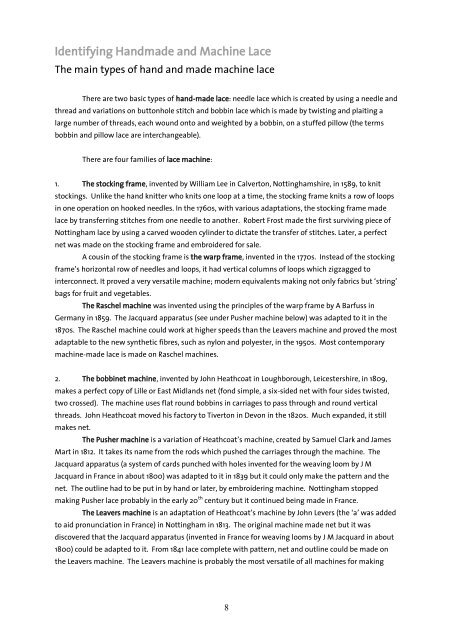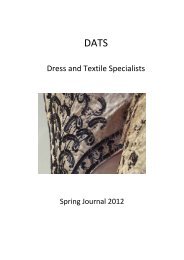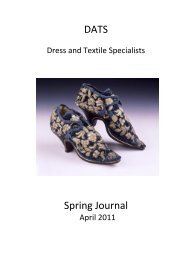Identifying Handmade and Machine Lace - Dress and Textile ...
Identifying Handmade and Machine Lace - Dress and Textile ...
Identifying Handmade and Machine Lace - Dress and Textile ...
Create successful ePaper yourself
Turn your PDF publications into a flip-book with our unique Google optimized e-Paper software.
<strong>Identifying</strong> <strong>H<strong>and</strong>made</strong> <strong>and</strong> <strong>Machine</strong> <strong>Lace</strong><br />
The main types of h<strong>and</strong> <strong>and</strong> made machine lace<br />
There are two basic types of h<strong>and</strong>-made lace: needle lace which is created by using a needle <strong>and</strong><br />
thread <strong>and</strong> variations on buttonhole stitch <strong>and</strong> bobbin lace which is made by twisting <strong>and</strong> plaiting a<br />
large number of threads, each wound onto <strong>and</strong> weighted by a bobbin, on a stuffed pillow (the terms<br />
bobbin <strong>and</strong> pillow lace are interchangeable).<br />
There are four families of lace machine:<br />
1. The stocking frame, invented by William Lee in Calverton, Nottinghamshire, in 1589, to knit<br />
stockings. Unlike the h<strong>and</strong> knitter who knits one loop at a time, the stocking frame knits a row of loops<br />
in one operation on hooked needles. In the 1760s, with various adaptations, the stocking frame made<br />
lace by transferring stitches from one needle to another. Robert Frost made the first surviving piece of<br />
Nottingham lace by using a carved wooden cylinder to dictate the transfer of stitches. Later, a perfect<br />
net was made on the stocking frame <strong>and</strong> embroidered for sale.<br />
A cousin of the stocking frame is the warp frame, invented in the 1770s. Instead of the stocking<br />
frame‟s horizontal row of needles <strong>and</strong> loops, it had vertical columns of loops which zigzagged to<br />
interconnect. It proved a very versatile machine; modern equivalents making not only fabrics but „string‟<br />
bags for fruit <strong>and</strong> vegetables.<br />
The Raschel machine was invented using the principles of the warp frame by A Barfuss in<br />
Germany in 1859. The Jacquard apparatus (see under Pusher machine below) was adapted to it in the<br />
1870s. The Raschel machine could work at higher speeds than the Leavers machine <strong>and</strong> proved the most<br />
adaptable to the new synthetic fibres, such as nylon <strong>and</strong> polyester, in the 1950s. Most contemporary<br />
machine-made lace is made on Raschel machines.<br />
2. The bobbinet machine, invented by John Heathcoat in Loughborough, Leicestershire, in 1809,<br />
makes a perfect copy of Lille or East Midl<strong>and</strong>s net (fond simple, a six-sided net with four sides twisted,<br />
two crossed). The machine uses flat round bobbins in carriages to pass through <strong>and</strong> round vertical<br />
threads. John Heathcoat moved his factory to Tiverton in Devon in the 1820s. Much exp<strong>and</strong>ed, it still<br />
makes net.<br />
The Pusher machine is a variation of Heathcoat‟s machine, created by Samuel Clark <strong>and</strong> James<br />
Mart in 1812. It takes its name from the rods which pushed the carriages through the machine. The<br />
Jacquard apparatus (a system of cards punched with holes invented for the weaving loom by J M<br />
Jacquard in France in about 1800) was adapted to it in 1839 but it could only make the pattern <strong>and</strong> the<br />
net. The outline had to be put in by h<strong>and</strong> or later, by embroidering machine. Nottingham stopped<br />
making Pusher lace probably in the early 20 th century but it continued being made in France.<br />
The Leavers machine is an adaptation of Heathcoat‟s machine by John Levers (the „a‟ was added<br />
to aid pronunciation in France) in Nottingham in 1813. The original machine made net but it was<br />
discovered that the Jacquard apparatus (invented in France for weaving looms by J M Jacquard in about<br />
1800) could be adapted to it. From 1841 lace complete with pattern, net <strong>and</strong> outline could be made on<br />
the Leavers machine. The Leavers machine is probably the most versatile of all machines for making<br />
8





